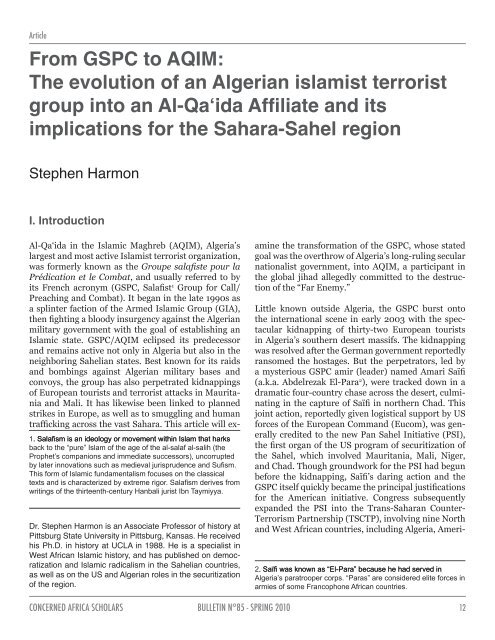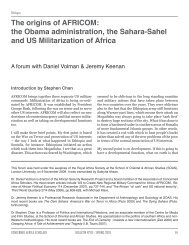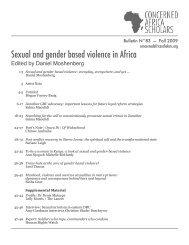Western Sahara and the United States' geographical imaginings
Western Sahara and the United States' geographical imaginings
Western Sahara and the United States' geographical imaginings
You also want an ePaper? Increase the reach of your titles
YUMPU automatically turns print PDFs into web optimized ePapers that Google loves.
Article<br />
From GSPC to AQIM:<br />
The evolution of an Algerian islamist terrorist<br />
group into an Al-Qa‘ida Affiliate <strong>and</strong> its<br />
implications for <strong>the</strong> <strong>Sahara</strong>-Sahel region<br />
Stephen Harmon<br />
I. Introduction<br />
Al-Qa‘ida in <strong>the</strong> Islamic Maghreb (AQIM), Algeria’s<br />
largest <strong>and</strong> most active Islamist terrorist organization,<br />
was formerly known as <strong>the</strong> Groupe salafiste pour la<br />
Prédication et le Combat, <strong>and</strong> usually referred to by<br />
its French acronym (GSPC, Salafist 1 Group for Call/<br />
Preaching <strong>and</strong> Combat). It began in <strong>the</strong> late 1990s as<br />
a splinter faction of <strong>the</strong> Armed Islamic Group (GIA),<br />
<strong>the</strong>n fighting a bloody insurgency against <strong>the</strong> Algerian<br />
military government with <strong>the</strong> goal of establishing an<br />
Islamic state. GSPC/AQIM eclipsed its predecessor<br />
<strong>and</strong> remains active not only in Algeria but also in <strong>the</strong><br />
neighboring Sahelian states. Best known for its raids<br />
<strong>and</strong> bombings against Algerian military bases <strong>and</strong><br />
convoys, <strong>the</strong> group has also perpetrated kidnappings<br />
of European tourists <strong>and</strong> terrorist attacks in Mauritania<br />
<strong>and</strong> Mali. It has likewise been linked to planned<br />
strikes in Europe, as well as to smuggling <strong>and</strong> human<br />
trafficking across <strong>the</strong> vast <strong>Sahara</strong>. This article will ex-<br />
. S�������m S�������m ��� ��� �� �� ��������y ��������y �� �� m�v��m���� m�v��m���� w������ w������ I����m I����m ����� ����� ����k�� ����k��<br />
b��k �� ����� “p����” I����m �� ����� ���� �� ����� ��������� ���������� ������<br />
P��p�����’�� ��mp������� ��� �mm�������� �����������������, �������p����<br />
by ������ ����v������� ������ ��� m������v�� j�����p��������� ��� S�����m.<br />
T����� ���m �� I����m�� �����m���������m ���������� �� ����� �����������<br />
���x��� ��� ��� ���������������� by ��x����m�� �����. S�������m �����v���� ���m<br />
w�������� �� ����� ����������������������y H��b��� j������ Ib� T�ym�yy�.<br />
Dr. Stephen Harmon is an Associate Professor of history at<br />
Pittsburg State University in Pittsburg, Kansas. He received<br />
his Ph.D. in history at UCLA in 1988. He is a specialist in<br />
West African Islamic history, <strong>and</strong> has published on democratization<br />
<strong>and</strong> Islamic radicalism in <strong>the</strong> Sahelian countries,<br />
as well as on <strong>the</strong> US <strong>and</strong> Algerian roles in <strong>the</strong> securitization<br />
of <strong>the</strong> region.<br />
amine <strong>the</strong> transformation of <strong>the</strong> GSPC, whose stated<br />
goal was <strong>the</strong> overthrow of Algeria’s long-ruling secular<br />
nationalist government, into AQIM, a participant in<br />
<strong>the</strong> global jihad allegedly committed to <strong>the</strong> destruction<br />
of <strong>the</strong> “Far Enemy.”<br />
Little known outside Algeria, <strong>the</strong> GSPC burst onto<br />
<strong>the</strong> international scene in early 2003 with <strong>the</strong> spectacular<br />
kidnapping of thirty-two European tourists<br />
in Algeria’s sou<strong>the</strong>rn desert massifs. The kidnapping<br />
was resolved after <strong>the</strong> German government reportedly<br />
ransomed <strong>the</strong> hostages. But <strong>the</strong> perpetrators, led by<br />
a mysterious GSPC amir (leader) named Amari Saïfi<br />
(a.k.a. Abdelrezak El-Para 2 ), were tracked down in a<br />
dramatic four-country chase across <strong>the</strong> desert, culminating<br />
in <strong>the</strong> capture of Saïfi in nor<strong>the</strong>rn Chad. This<br />
joint action, reportedly given logistical support by US<br />
forces of <strong>the</strong> European Comm<strong>and</strong> (Eucom), was generally<br />
credited to <strong>the</strong> new Pan Sahel Initiative (PSI),<br />
<strong>the</strong> first organ of <strong>the</strong> US program of securitization of<br />
<strong>the</strong> Sahel, which involved Mauritania, Mali, Niger,<br />
<strong>and</strong> Chad. Though groundwork for <strong>the</strong> PSI had begun<br />
before <strong>the</strong> kidnapping, Saïfi’s daring action <strong>and</strong> <strong>the</strong><br />
GSPC itself quickly became <strong>the</strong> principal justifications<br />
for <strong>the</strong> American initiative. Congress subsequently<br />
exp<strong>and</strong>ed <strong>the</strong> PSI into <strong>the</strong> Trans-<strong>Sahara</strong>n Counter-<br />
Terrorism Partnership (TSCTP), involving nine North<br />
<strong>and</strong> West African countries, including Algeria, Ameri-<br />
. S���� S���� w��� w��� k��w� k��w� ��� ��� “E��P���” “E��P���” b��������� b��������� ���� ���� ���� ���� �����v��� �����v��� �� ��<br />
A�������’�� p�������p��� ���p��. “P�����” ���� ������������� ������� �������� ��<br />
��m����� �� ���m�� F�����p������ A������ �����������.<br />
CONCERNED AFRICA SCHOLARS BULLETIN N°85 - SPRING 2010 12




